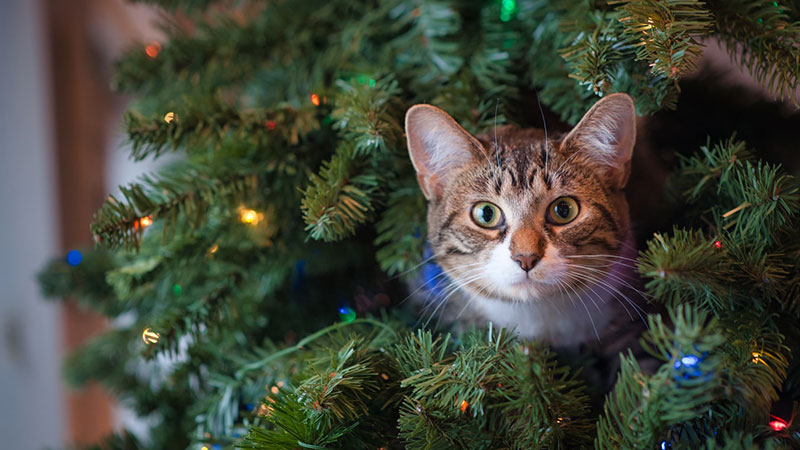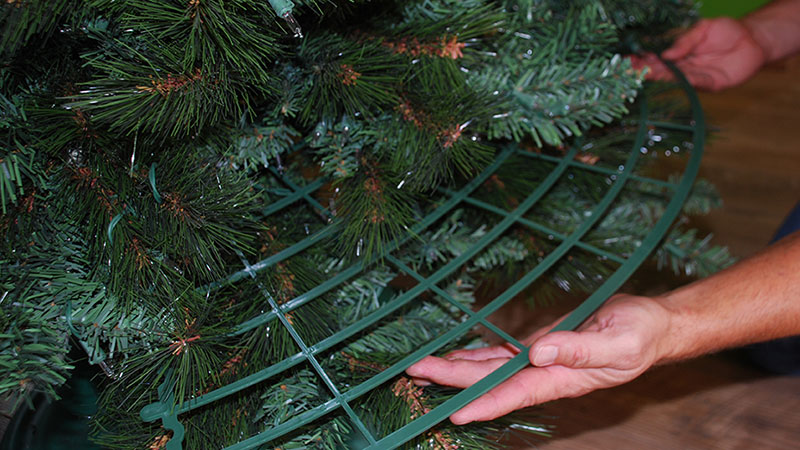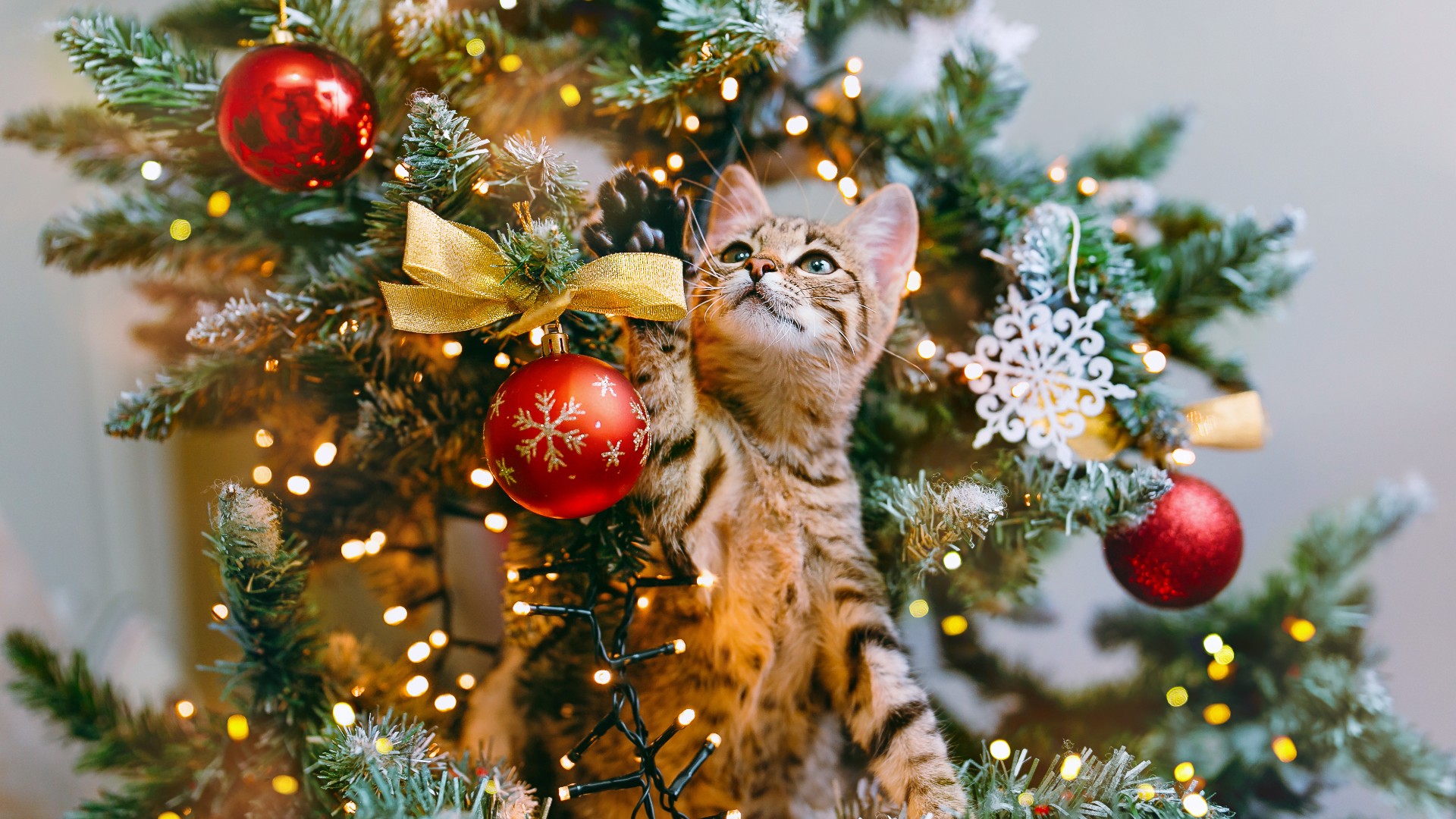7 ways to cat-proof Christmas trees
Our top tips to cat-proof Christmas trees will ensure your curious kitty is protected this holiday season

Learning how to cat-proof Christmas trees is one skill that’s definitely well worth mastering if you have a curious kitty who’s prone to batting about your beautiful baubles, using the trunk as a scratching post, or getting themselves all tangled up in twinkly lights.
Although the best cat toys do a great job of keeping our feline friends occupied and entertained throughout most of the year, come December, our beloved bundles of fluff just can’t help themselves when they see the decorations and tinsel being brought out again.
Thankfully, the sound of smashing ornaments and tinsel being ripped off the tree (quite possibly followed by it toppling over!) needn’t define the holiday season in your home this year, thanks to these clever tips and tricks for how to cat-proof your Christmas tree.
Why do I need to cat-proof Christmas trees?
While it's adorable to see your cat interested in a Christmas tree, peeking in through the branches, or batting around ornaments, believe it or not, there are a number of Christmas hazards for pets that lurk around your home during the holiday season and your tree is definitely one of them.
So, what exactly is it about the seemingly innocent Christmas tree that poses such a risk to your cat’s health and wellbeing? Well, for starters, most of our feline friends love nibbling on tinsel and evergreen needles, both of which can cause intestinal blockages if they’re ingested.
Then there’s the water that you give your tree to keep it alive over the holidays. While tree water may sound harmless, most trees are actually sprayed with fire retardants before they’re sold and have usually been treated with insecticides prior to being felled. Alongside pine sap, which is toxic to cats, these products leach into the water, making it unfit for consumption.
And while all those twinkling lights make the festive season magical for us humans, they can be very dangerous for our fur friends who may end up with thermal burns if they chew on the wires. In addition to this, cats can be injured by broken lights and ornaments, with sharp edges causing cuts and lacerations.
Get the best advice, tips and top tech for your beloved Pets
To avoid all these potential cat calamities this Christmas, here are our top tips for keeping your kitty and your tree as far apart as possible over the holidays…..
1. Location, location, location!
We know the Christmas tree is usually the centerpiece of your home at Christmas. However, if it it possible, keep your tree in a room which you can close off to your cat when you aren’t there to stop them attacking or climbing it. This will stop your cat investigating it without supervision and prevent midnight marauding.
If your tree is small enough, and you have a way of securing it, putting it out of reach of your cat may make them lose interest. At the least, keep it away from shelves or surfaces your cat can jump from so they can’t leap on to it from above.
Wherever you put it, ensure it isn’t easily pulled or pushed over by your pets by using a heavy solid base, and securing it to a wall with some wire to help keep it from being toppled over.

2. Use discouraging smells
Although lion dung is a highly recommended way to keep cats out of your garden, you probably don’t want that in your living room. Fortunately, there are some more smells that felines tend to dislike that you can use to keep cats away from your Christmas tree.
First of all, there are shop-bought cat-deterrent sprays, which you can spray over your tree so your furry friend will turn its nose up at it. They are scented with smells designed to be unpleasant to cats, but not to people. There are also automatic sprays that only spray when they detect motion in a place you don’t want your pet to be, which can be a more effective deterrent.
For a more home-made approach you could place a few treated pinecones at the base of the tree. Spray them with something like apple-cider vinegar – which most cats don’t like the smell of – and it should keep your cats at bay. Other smells to consider are orange and apple, which cats also avoid. Some dried orange peel placed around the base of the tree could help keep cats off it.
3. Use foil and other Christmas tree defenders
Cats tend to climb Christmas trees using the trunk rather than the flimsier branches, so if you can put them off at the base, they may give up. An easy way to do this is to wrap the base of your tree and trunk in foil. Most cats don’t like the feel of foil on their paws, and aren’t keen on the noise it makes when they walk on it. You can decorate the foil too, so it isn’t too much of an eyesore.
You can also buy barriers such as Christmas tree defenders which fit around the trunk to prevent them from climbing it. This won’t stop them leaping on to it from a handy shelf, but if the only way up is from the bottom then it’s very effective.
Other people have reported some success with putting cats off investigating their Christmas trees by adding other objects with textures cats don’t like under the tree. For examples, pine cones or double-sided sticky tape – both are known to deter fussy felines.

4. Keep the decorations up high
Don’t hang ornaments, tinsel, or Christmas lights low down on the tree where cats can easily see and get to them – if they are out of their line of sight, they may not notice the dangling treats above them. If you are worried about the tree looking bare, use less shiny objects lower down which will be less of an attraction to your cat.
It’s also a good idea to securely attach your decorations to the tree. That way, if they do get to them your cat can’t damage themselves by pulling them down and smashing them on the floor. Using tightly wrapped wire ties can ensure the tree ornaments stay where they belong.
It may also be worth delaying decorating your tree until your cat has got used to this new addition to the house. Once it’s got to used to the bare tree, you can add the tempting decorations later.
5. Avoid tinsel and other shiny objects
Tinsel and cats simply should not mix. You couldn’t design a more perfect shiny, dangling temptation for your furry friends. It’s also the ideal tool for your inquisitive feline to pull the tree down on top of them. What’s more, it can make your cat ill if, as well as attacking it, it decides to eat it.
Although most tinsels are not toxic to cats, it is a choking hazard, and if ingested it can get stuck in their intestines causing blockages. Paper alternatives, chains, or thick ribbons won’t catch your cat’s eye anywhere near as much, particularly if not placed at your cat’s level.
Similarly, shiny, light-reflecting baubles are like catnip to curious cats. Consider toning down your tree ornaments, and your cat may not consider them worth bothering investigating.

6. Choose a slimmer Christmas tree
You can discourage cats from wanting to climb your tree if there are less places to nose through and hide in. Pencil trees – slimline versions of Xmas trees – may put your cat off wanting to explore. They have the added bonus that you need less room to display and store them, and they cost a lot less to decorate!
7. Fence off your Christmas tree
This may seem like an extreme option, but if all else has failed it may be worth using a free-standing pet safety gate or small pet exercise pen to help fend them off. Wooden varieties of pet gates and fences aren’t as harsh looking as metal ones, and can be used to keep them out of other areas when the holiday season is over.
You might also want to read: The best Advent calendars for cats and Should I get a kitten for Christmas?
Jamie Middleton is a freelance editor and writer who has been editing and creating content for magazines and websites for over 20 years. As well as writing about the pets he loves, he has helped create websites about tech and innovation like TechRadar.com, Innovate UK and TechSPARK, written programmes for music festivals, books on inventions and architecture, TV listings magazines, and edited publications about cars such as Lexus, Toyota and Jaguar. In his spare time he writes fiction books and poetry - or at least he does when he is permitted to by his cat Pirate, who enjoys the warmth of laptops too much to allow being creative to get in the way.

